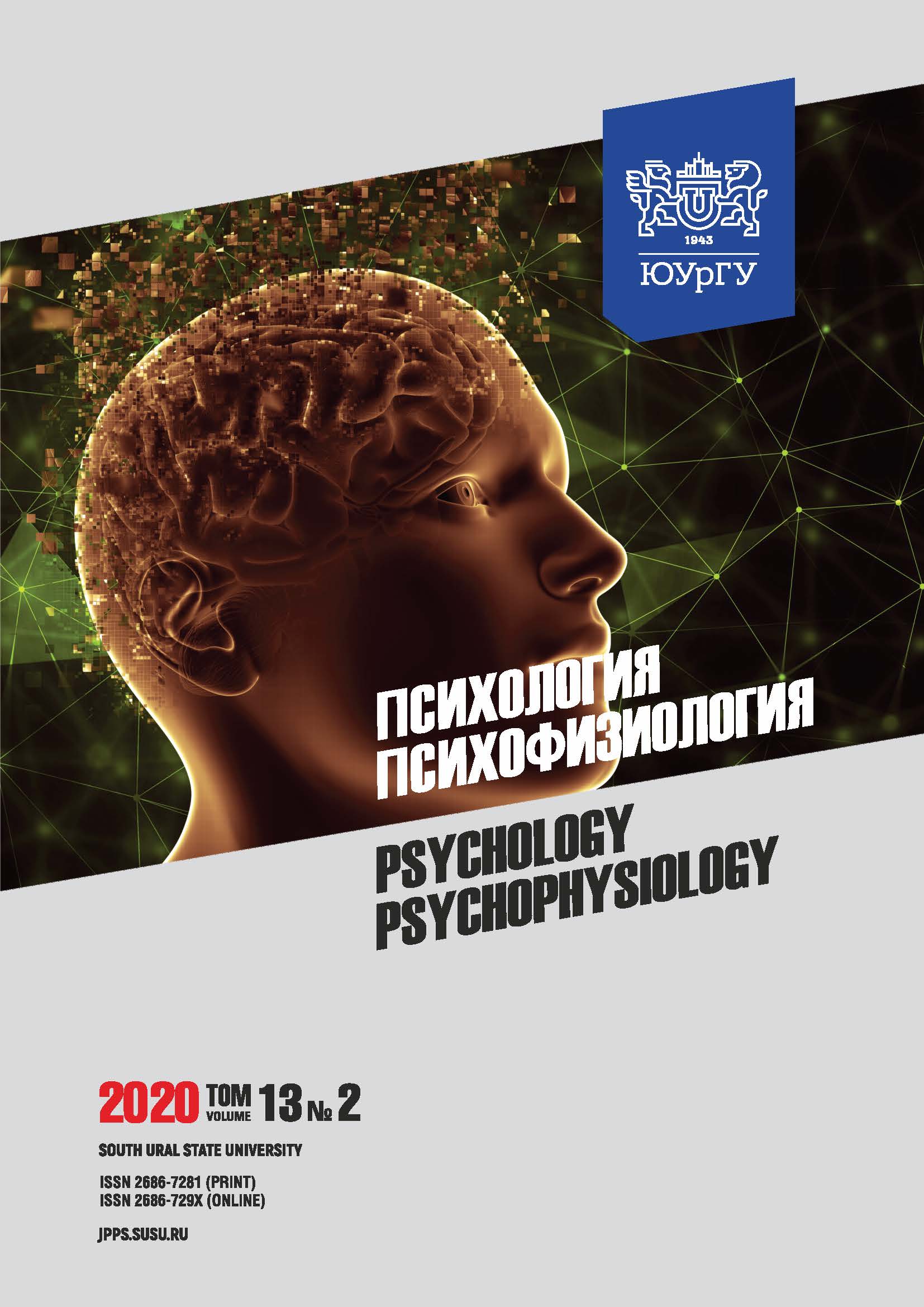BIOELECTRIC ACTIVITY OF THE BRAIN IN PUPILS WITH DIFFERENT ACADEMIC SUCCESS. REPORT 1. CHILDREN WITH DIFFERENT ACADEMIC SUCCESS AS REPRESENTATIVES OF THE AGE NORM
Abstract
Background. Studying the bioelectric activity of the brain allows scientists to get a picture of brain functioning, including cognitive activity. The sensitivity of this method allows identifying and explaining subtle differences between children with different academic success, representatives of the age norm. However, additional research is needed to develop and substantiate measures of psychological and pedagogical support for schoolchildren for increasing their academic success. Aim. The paper aims to study rest and cognitive load EEG data in 12-year-old children and assess the compliance of these data with the age norm. Materials and methods. Twelve-year-old children participated in the study, both males (n = 25) and females (n = 26). The EEG was recorded using the CONAN-m equipment, and the electrodes were mounted according to a 10–20 system. The study was carried out under four experimental conditions: at rest and under cognitive load, which consisted of solving three types of tasks (verbal-logical, arithmetic, and spatial rotation of a figure). EEG spectral characteristics were evaluated depending on the recording conditions. Results. It was found that predominant alpha-range frequency in females was from 9.6 to 9.8 Hz, in boys it was slightly higher (about 9.9–10.1 Hz). Response to cognitive load was slightly different depending on the type of task. In general, it consisted of a slight increase in theta and beta ranges and a decrease in bioelectric activity in the alpha range. In males, an asymmetric, cross-type activation was found with a more pronounced alpha rhythm depression in the left frontal, temporal and right occipital regions. Conclusion: In general, the examined sample corresponded to the age norm according to rest and cognitive load EEG.
Downloads
References
2. Aiusheeva T.A., Saprygin A.E., Savostyanov A.N., Stеpanova V.V. [Behavioral and EEG reactions in primary school-aged children to emotionally colored verbal stimuli with the condition of their own or forced choice]. Sotsialnaya psikhologiya i obshchestvo [Social Psychology and Society], 2017, vol. 8, no. 4, pp. 72–90. DOI: 10.17759/sps.2017080406 (in Russ.).
3. Bezrukikh M.M., MacHinskaya R.I., Farber D.A. [Structural and functional organization of a developing brain and formation of cognitive functions in child ontogeny]. Fiziologiya cheloveka [Human Physiology]. 2009, vol. 35, no. 6, pp. 10–24. (in Russ.).
4. Vyatleva O.A., Teksheva L.M., Kurgansky A.M. [Physiological and hygienic assessment of the impact of mobile phones with various radiation intensity on the functional state of brain of children and adolescents according to electroencephalographic data]. Gigiena i sanitariya [Hygiene & sanitation], 2016, vol. 95, no. 10, pp. 965–968 (in Russ.). DOI: 10.18821/0016-9900-2016-95-10-965-968
5. Gorev A.S. [Age-specific neurophysiological basis of voluntary regulation of functional state in children aged 10-11 years old]. Novye issledovaniya [New study], 2013, no. 4, pp. 102–114. (in Russ.).
6. Gribanov A.V., Dzhos Y.S., Bagretsova T.V., Biruykov I.S. [Photoperiodism and changes in brain bioelectric activity in schoolchildren in the arctic zone]. Fiziologiya cheloveka [Human Physiology], 2016, vol. 42, no. 2, pp. 128–136. DOI: 10.7868/S0131164616020065 (in Russ.).
7. Zvyagina N.V., Matigorova I.V. [Age-related reorganization of bioelectric activity of the brain in the process of visual perception]. Vestnik Pomorskogo universiteta. Seriya: Fiziologicheskie i psikhologo-pedagogicheskie nauki [Bulletin of the Pomeranian University. Series: Physiological and psychological-pedagogical Sciences], 2007, no. 1, pp. 36–43. (in Russ.).
8. Kazakova E.V., Sokolova L.V., Koposova T.S. [Indicators of functional maturity of cerebral hemispheres in first-year primary school students from the risk groups for early dysontogeny]. Fiziologiya cheloveka [Human Physiology], 2009, vol. 35, no. 5, pp. 13–18. (in Russ.).
9. Lapshina L.M. [Some features of bioelectric activity of the brain (alpha-rhythm) of primary school children diagnosed with F70]. Vestnik ChGPU: Biologicheskie nauki [Bulletin of CHPU: Biological Sciences], 2009, no. 7, pp. 290–296. (in Russ.).
10. Machinskaya R.I. [Neurophysiological mechanisms of voluntary attention: a review]. Zhurnal vysshei nervnoi deyatelnosti im. I.P. Pavlova [Zh Vyssh Nerv Deiat Im I.P. Pavlova], 2003, vol. 53, no. 2, pp. 133–150. (in Russ.).
11. Neirodinamika mozga pri optiko-gnosticheskoi deyatelnosti [Neurodynamics of the brain in opto-Gnostic activity]. Ed. E.A. Zhirmunskaya, E.S. Bein. Moscow, Medicine Publ., 1974. 159 p. (in Russ.).
12. Pavlova L.P., Romanenko A.F. Sistemnyi podkhod k psikhofiziologicheskomu issledovaniyu mozga cheloveka [System approach to psychophysiological research of the human brain]. Leningrad, Nauka, 1988. 213 p. (in Russ.).
13. Soboleva I.V., Naumova E.S. [Age features of the space-time organization ofthe EEG of pupils with different profile of lateral organization. Post 1. EEG power spectra]. Valeologiya [Journal of health and life sciences], 2013, no. 3, pp. 133–143. (in Russ.).
14. Stankova E.P., Shepovalnikov A.N. [Functional connectivity of cortical fields at rest as a mechanism of brain preparation to purposeful activity]. Fiziologiya cheloveka [Human Physiology], 2018, vol. 44, no. 6, pp. 5–14. (in Russ.).
15. Farber D.A., Beteleva T.G., Gorev A.S. et al. Funktsionalnaya organizatsiya razvivayushchegosya mozga v formirovanii kognitivnoi deyatelnosti [Functional organization of the developing brain in the formation of cognitive activity] Fiziologiya razvitiya rebenka: teoreticheskie i prikladnye aspekty [Physiology of child development: theoretical and applied aspects]. Ed. M.M. Bezrukikh, D.A. Farber. Moscow, 2000. pp. 82–105. (in Russ.).
16. Lenroot R.K., Giedd J.N. Sex differences in the adolescent brain. Brain Cogn, 2010, vol. 72 (1), pp. 46–55.
17. Rocha F.T. Rocha A.F., Massad E., Menezes R. Brain mappings of the arithmetic processing in children and adults. Cognitive Brain Research, 2005, vol. 22, no. 3, pp. 359–372. DOI: 10.1016/j.cogbrainres.2004.09.008
18. Rubia K., Hyde Z., Halari R., Giampietro V., Smith A. Effects of age and sex on developmental neural networks of visual-spatial attention allocation. Neuroimage, 2010, vol. 51 (2), pp. 817–827. DOI: 10.1016/j.neuroimage.2010.02.058
References on translit
Copyright (c) 2020 Psychology. Psychophysiology

This work is licensed under a Creative Commons Attribution-NonCommercial-NoDerivatives 4.0 International License.



